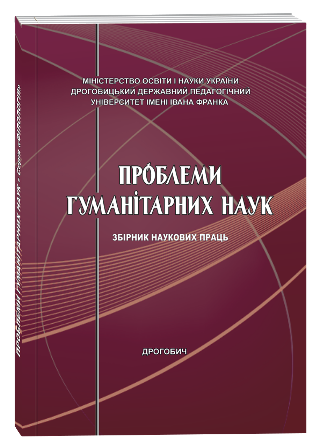ПОНЯТТЯ «ФЕЙКОВІ НОВИНИ» В АНГЛОМОВНОМУ МЕДІАПРОСТОРІ
DOI:
https://doi.org/10.24919/2522-4565.2023.57.2Keywords:
Fake news, «viral», disinformation, misinformation, information, contentAbstract
This research article delves into the theoretical foundations necessary for a comprehensive study of fake news in the English-language media space. The author begins with a historical overview of the definition of fake news, tracing its evolution and different interpretations over time. This historical perspective provides a valuable context for understanding the current challenges posed by fake news and emphasizes the need for a nuanced theoretical framework to address the complex issues surrounding the phenomenon. The article goes on to examine fake news stories in politics, focusing on well-known examples such as the 2016 US election, the 2019 Australian election and Brexit. By examining these examples, the author illustrates the profound impact of fake news on political processes, including voter behaviour, election results, and public trust in democratic institutions. This analysis emphasizes the urgency of studying fake news in a political context and its implications for democratic governance. In addition to the political implications, the article also delves into the legal aspect of defining fake news. Despite the growing concern around fake news, legislatures have not yet provided a clear definition of the phenomenon. Instead, they have proposed characteristics that reflect its deceptive nature and harmful effects. By analyzing the legal landscape surrounding fake news, the author sheds light on the challenges of regulating disinformation in the digital age and the limitations of the legal framework in combating its spread. The author also analyzes the feasibility of the concept of «fake news» and the views of both legislative bodies of English-speaking countries and cultural figures and researchers in these countries. The author also analyzes the correlation and interrelation of fake news with such concepts as «disinformation», «misinformation», etc.
References
Addley E. Fake anti-Brexit banknotes added to British Museum collection. The Guardian. 2019. August 9.
Araújo A.C. The Lisbon Earthquake of 1755 : Public Distress and Political Propaganda. e.Journal of Portuguese History. 2006. № 4.
Carlson T. [@TuckerCarlson]. Tucker on Twitter, Ep.1. X. 2023, June 7. URL : https://twitter.com/i/status/1666203439146172419.
Classification Office. New Zealand is facing unprecedented challenges in the digital age. 2020. URL : https://www.beehive.govt.nz/sites/default/files/2020-12/Classification%20Office.pdf.
Collins-Dictionary. Collins 2017 word of the year shortlist. 2017. URL : www.collinsdictionary.com/wordlovers-blog/new/collins-2017-word-of-the-year-shortlist,396,HCB.html.
Corner J. Fake news, post-truth and media–political change. Media, Culture & Society. 2017. Vol. 39(7). P. 1100–07.
Cunha E., Magno G., Caetano J., Teixeira D., Almeida V. Fake news as we feel it: Perception and conceptualization of the term “fake news” in the media. Social informatics : SocInfo 2018 : Lecture notes in computer science / S. Staab, O. Koltsova, & D. Ignatov (Eds.). 2018. Vol. 1118. P. 151–166.
Egelhofer J.L., Lecheler S. Fake news as a two-dimensional phenomenon : A framework and research agenda. Annals of the International Communication Association. 2019. Issue 43. №2. P. 97–116.
Fleming J. Media Literacy, News Literacy, or News Appreciation? A Case Study of the News Literacy Program at Stony Brook University. Journalism & Mass Communication Educator. 2014. 69(2). P. 146–165.
Hamilton Daily Democrat. 1893, January 27. Р. 3.
Hobbs R., Seyferth-Zapf, C., Grafe, S. Using Virtual Exchange to Advance Media Literacy Competencies through Analysis of Contemporary Propaganda. Journal of Media Literacy Education. 2018. 10(2). P. 152–168.
Irby K. You Think You Can Recognize Fake News? So Does Most of the Country. Sacramento Bee. 2016. December 15.
Liberal Party of Australia. Why is Bill Shorten so defensive about an inheritance tax? YouTube. 2019. URL : https://www.youtube.com/watch?v=f0D8o8yGFMQ.
Lippmann W. Public Opinion, London : Transaction Publishers. 1997. P. 364–365.
Tandoc E. C., Lim, Z. W., Ling, R. Defining “Fake News” : A typology of scholarly definitions. Digital Journalism. 2018. 6(2), P. 137–53.
UK Parliament. Disinformation and ‘Fake News’: Interim Report, Fifth Report of Session 2017–19. London, UK, 2018.
UK Parliament. Disinformation and ‘Fake News’: Final Report, Fifth Report of Session 2017–19. London, UK, 2019.
Van der Linden S., Roozenbeek J. A psychological vaccine against fake news. The psychology of fake news : Accepting, sharing, and correcting misinformation / by ed. R. Greifeneder, M. Jaffé, E. J. Newman, & N. Schwarz. London: Routledge, 2020. Р. 147–169.
Vosoughi Soroush et al. The spread of true and false news online. Science (New York, N.Y). 2018. Vol. 359, 6380. Р. 1146–1151.
Wardle C., Derakhshan H. Information disorder : Toward an interdisciplinary framework for research and policy making. Strasbourg : Council of Europe. 2017.



